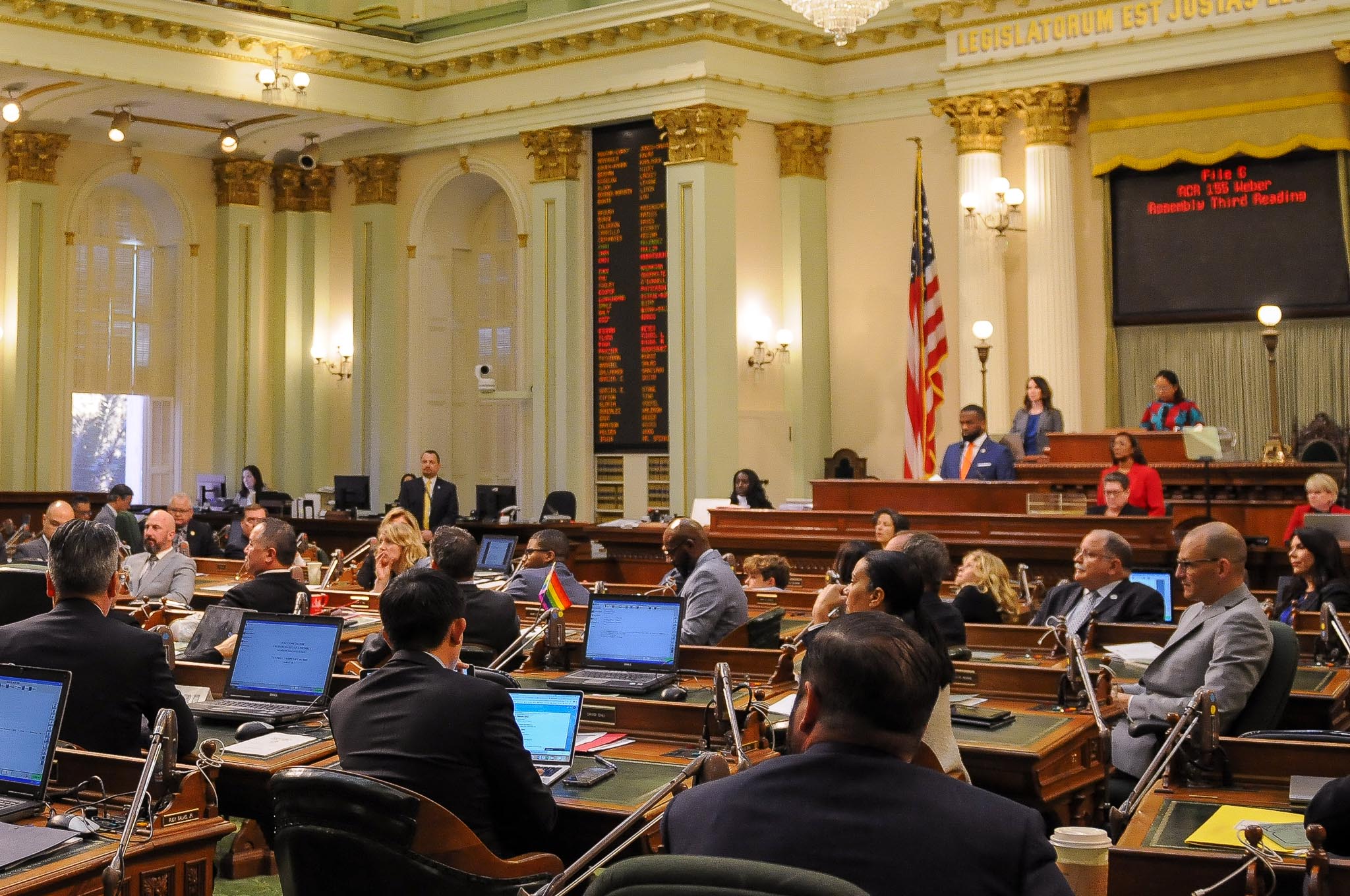
Vote buttons for election. (Photo: 3dfoto/Shutterstock)
Frequently Asked Questions about California Election Law
What does the state Constitution provide regarding elections?
By Chris Micheli, January 7, 2024 2:30 am
What constitutional provisions apply to California’s elections? They are governed by Article II of the state Constitution, as well as the extensive Elections Code.
What does the state Constitution provide regarding elections? Article II, which deals with voting, initiatives, referendums, and recall, was amended by Proposition 14 on the June 9, 1976 ballot. Article II contains twenty sections.
What does Section 1 provide? It specifies that all political power is inherent in the people. Government is instituted for the people’s protection, security, and benefit, and they have the right to alter or reform it when the public good may require.
What does Section 2 provide? It provides that a United States citizen who is 18 years of age and a resident in this State may vote.
What does Section 2.5 provide? It specifies that a voter who casts a vote in an election in accordance with the laws of this State must have that vote counted.
What does Section 3 provide? It provides that the Legislature defines residence and provides for voter registration and free elections.
What does Section 4 provide? It states that the Legislature must prohibit improper practices that affect elections and provide for the disqualification of electors while mentally incompetent or imprisoned or on parole for the conviction of a felony.
What does Section 5 provide? It provides that a voter-nomination primary election is to be conducted to select the candidates for congressional and state elective offices in California. The candidates who are the top two vote-getters at a voter-nominated primary election for a congressional or state elective office must, regardless of party preference, compete in the ensuing general election.
What does Section 6 provide? It states that all judicial, school, county, and city offices, including the Superintendent of Public Instruction, are to be nonpartisan.
What does Section 7 provide? It requires that voting be secret.
What does Section 8 provide? It provides that the initiative is the power of the electors to propose statutes and amendments to the Constitution and to adopt or reject statutes. In addition, an initiative measure may be proposed by presenting to the Secretary of State a petition that sets forth the text of the proposed statute or amendment to the Constitution and is certified to have been signed by electors equal in number to 5 percent in the case of a statute, and 8 percent in the case of an amendment to the Constitution, of the votes for all candidates for Governor at the last gubernatorial election.
What does Section 9 provide? It provides that the referendum is the power of the electors to approve or reject statutes or parts of statutes except urgency statutes, statutes calling elections, and statutes providing for tax levies or appropriations for usual current expenses of the State. In addition, a referendum measure may be proposed by presenting to the Secretary of State, within 90 days after the enactment date of the statute, a petition certified to have been signed by electors equal in number to 5 percent of the votes for all candidates for Governor at the last gubernatorial election, asking that the statute or part of it be submitted to the electors.
What does Section 10 provide? It states that an initiative statute or referendum approved by a majority of votes cast takes effect on the fifth day after the Secretary of State files the statement of the vote for the election at which the measure is voted on, but the measure may provide that it becomes operative after its effective date. If a referendum petition is filed against a part of a statute, the remainder of the statute is not delayed from going into effect.
In addition, if the provisions of two or more measures approved at the same election conflict, the provisions of the measure receiving the highest number of affirmative votes prevails and is enacted. The Legislature may amend or repeal a referendum statute. Moreover, before circulation of an initiative or referendum petition for signatures, a copy shall be submitted to the Attorney General who prepares a title and summary of the measure as provided by law.
What does Section 11 provide? It states that initiative and referendum powers may be exercised by the electors of each city or county under procedures that the Legislature provides, except for a city having a charter.
What does Section 12 provide? It states that no amendment to the Constitution, and no statute proposed to the electors by the Legislature or by initiative, that names any individual to hold any office, or names or identifies any private corporation to perform any function or to have any power or duty, may be submitted to the electors or have any effect.
What does Section 13 provide? It specifies that the recall is the power of the electors to remove an elective officer.
What does Section 14 provide? It provides that recall of a state officer is initiated by delivering to the Secretary of State a petition alleging a reason for recall. Sufficiency of the reason is not reviewable. Proponents have 160 days to file signed petitions.
In addition, a petition to recall a statewide officer must be signed by electors equal to 12 percent of the last vote for the office, with signatures from each of 5 counties equal in number to 1 percent of the last vote for the office in the county. Signatures to recall Senators, members of the Assembly, members of the Board of Equalization, and judges of courts of appeal and trial courts must equal in number 20 percent of the last vote for that office.
What does Section 15 provide? An election to determine whether to recall an officer and, if appropriate, to elect a successor must be called by the Governor and held not less than 60 days nor more than 80 days from the date of certification of sufficient signatures.
In addition, a recall election may be conducted within 180 days from the date of certification of sufficient signatures in order that the election may be consolidated with the next regularly scheduled election occurring wholly or partially within the same jurisdiction in which the recall election is held, if the number of voters eligible to vote at that next regularly scheduled election equal at least 50 percent of all the voters eligible to vote at the recall election.
Finally, if the majority vote on the question is to recall, the officer is removed and, if there is a candidate, the candidate who receives a plurality is the successor. The officer may not be a candidate.
What does Section 16 provide? The Legislature must provide for circulation, filing, and certification of petitions, nomination of candidates, and the recall election.
What does Section 17 provide? If recall of the Governor or Secretary of State is initiated, the recall duties of that office are to be performed by the Lieutenant Governor or Controller, respectively.
What does Section 18 provide? A state officer who is not recalled must be reimbursed by the State for the officer’s recall election expenses legally and personally incurred. Another recall may not be initiated against the same officer until six months after the election.
What does Section 19 provide? The Legislature must provide for recall of local officers. This section does not affect counties and cities whose charters provide for recall.
What does Section 20 provide? Terms of elective offices provided for by this Constitution, other than Members of the Legislature, commence on the Monday after January 1 following election. The election must be held in the last even-numbered year before the term expires.
- Offenses Under the State Contract Act - November 21, 2024
- California Levying Officer Electronic Transactions Act - November 21, 2024
- 2023-24 California Legislative Session: A Look at Regular Session Bills - November 20, 2024





We still have election laws in California?
Do any sections prohibit election activities that are insecure, inaccurate or outright fraudulent as described by this election security firm’s findings which documents, and explains away, MULTIPLE security exploits inherent in the system:
https://votingsystems.cdn.sos.ca.gov/vendors/dominion/dvs510staff-report.pdf
Our rights as election observers are being whittled away. Perfect for elites who don’t trust average citizens to decide election outcomes.
https://open.substack.com/pub/grandmasnews/p/election-observers-testify-they-cant?r=1g1zw5&utm_campaign=post&utm_medium=web